Carbide Base Diamond decoupling footer is a more advanced costlier version of a product I’ve reviewed two springs ago. Now it’s time to find out whether this newcomer is any good. Enjoy!
Diamond progress
Although 2021 isn’t a distant past, it may seem like an eternity if you’re a part of the audio industry. Two years are time long enough for some manufacturers to rework their entire lineups, while others spend it on perfecting just one design. The company Carbide Audio fits the latter profile. It was established in 2019 in Texas and locates in the city of Llano. Its introductory decoupling footer named Carbide Base was launched in July 2021 and I had the pleasure of reviewing it several months later. The founder of this audio house – Jeffrey Jenkins – didn’t rush his first commercial effort for a reason. Suffice it to say, landing a highly unusual accessory worthy of a US patent had to take a while. To recap, the man’s a software engineer into digital room correction and psychoacoustics, who took the subject of resonance control under his scope, and then went with it further than most hobbyists would. Jeffrey’s programming skills proved useful in writing code for CNC hardware in his own machine shop, so he could conveniently turn his digital designs into working prototypes in house. All that on top of him being one inquisitive type with a knack for mechanics resulted in a portfolio opener that had me pleasantly surprised.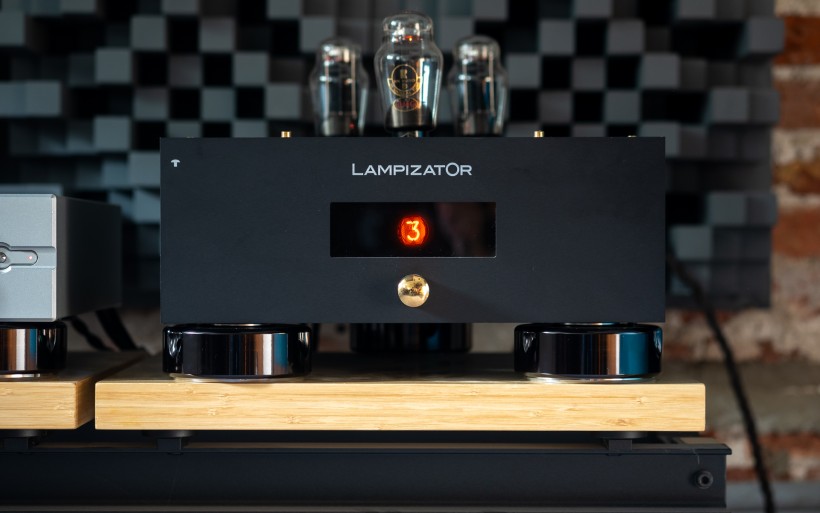 Jeffrey’s Carbide Bases performed very well where it mattered most, especially considering their reasonable retail price. These land mines infused with large viscoelastic inserts and roller bearings also were unlike any other such a product I’ve sampled or was aware of. Decoupling accessories divide into either soft or hard, but Jeff’s hybrid affair was designed to handle horizontal and vertical movement by cleverly combining both these approaches. The company’s viscoelastic ring named ViscoRing acts like a spring with low spring rate. This inherently lossy component converts 65% of energy from vertical vibrations into heat and features wide isolation bandwidth and low resonant frequency. When sufficiently thin and tall, it also beats metal springs on resonance dissipation aka damping. This necessity effectively dictated the product’s substantial 64 x 124mm frame and was the main engineering issue its maker had to overcome.
Jeffrey’s Carbide Bases performed very well where it mattered most, especially considering their reasonable retail price. These land mines infused with large viscoelastic inserts and roller bearings also were unlike any other such a product I’ve sampled or was aware of. Decoupling accessories divide into either soft or hard, but Jeff’s hybrid affair was designed to handle horizontal and vertical movement by cleverly combining both these approaches. The company’s viscoelastic ring named ViscoRing acts like a spring with low spring rate. This inherently lossy component converts 65% of energy from vertical vibrations into heat and features wide isolation bandwidth and low resonant frequency. When sufficiently thin and tall, it also beats metal springs on resonance dissipation aka damping. This necessity effectively dictated the product’s substantial 64 x 124mm frame and was the main engineering issue its maker had to overcome.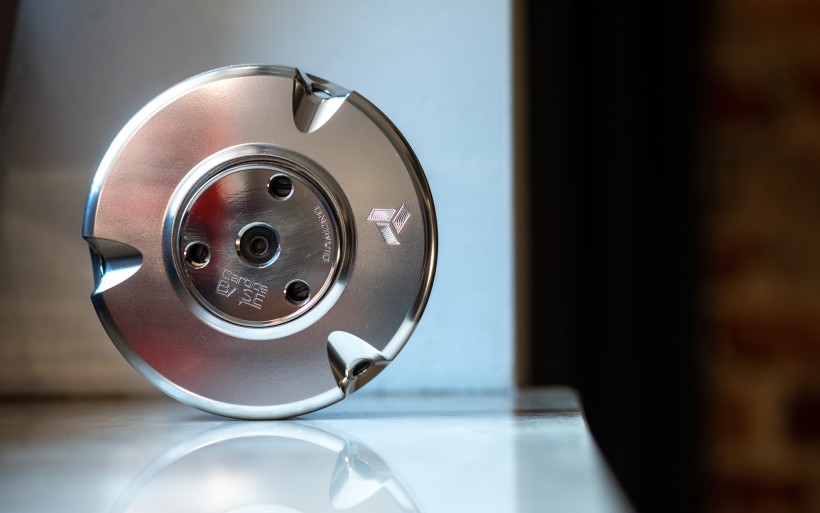 Although its dress code doesn’t show, Carbide Base proved to be internally quite intricate. The threaded bottom part adjusts the entire structure’s height and connects to the upper plate, while 6 x 3 petite zirconia balls in-between these sections introduce mild horizontal play. The latter round component also is the bed for a ViscoRing of choice, while the large upper enclosure piece keeps this critical rubbery ingredient mechanically stable, so that it can compress and efficaciously execute its core task without bulging outwards. Carbide’s pucks feature threaded 1/4″-20 openings on their top and bottom, so one can firmly attach them i.e. to a DAC or speaker, or use optional spikes to save floor. These footers work best near their upper loading range when their resonant frequency is the lowest, which is why a customer selects one of five available ViscoRing types upon order. A set of three pucks with green/gray/blue/black/red cylindrical inserts respectively supports loads up to 25/50/100/200/600kg, while four push these numbers to 35/70/140/280/800kg. Should you wish to replace viscoelastic internals in footers you already own, the key included in the box and several minutes of your time is all it takes to do that. Just unscrew three bolts on the top cover to remove it, then replace its essential a bit sticky soft part by hand, pop that enclosure back on and bolt it to the base. Simple. The manufacturer wants $29 for one ring, which is not a lot.
Although its dress code doesn’t show, Carbide Base proved to be internally quite intricate. The threaded bottom part adjusts the entire structure’s height and connects to the upper plate, while 6 x 3 petite zirconia balls in-between these sections introduce mild horizontal play. The latter round component also is the bed for a ViscoRing of choice, while the large upper enclosure piece keeps this critical rubbery ingredient mechanically stable, so that it can compress and efficaciously execute its core task without bulging outwards. Carbide’s pucks feature threaded 1/4″-20 openings on their top and bottom, so one can firmly attach them i.e. to a DAC or speaker, or use optional spikes to save floor. These footers work best near their upper loading range when their resonant frequency is the lowest, which is why a customer selects one of five available ViscoRing types upon order. A set of three pucks with green/gray/blue/black/red cylindrical inserts respectively supports loads up to 25/50/100/200/600kg, while four push these numbers to 35/70/140/280/800kg. Should you wish to replace viscoelastic internals in footers you already own, the key included in the box and several minutes of your time is all it takes to do that. Just unscrew three bolts on the top cover to remove it, then replace its essential a bit sticky soft part by hand, pop that enclosure back on and bolt it to the base. Simple. The manufacturer wants $29 for one ring, which is not a lot.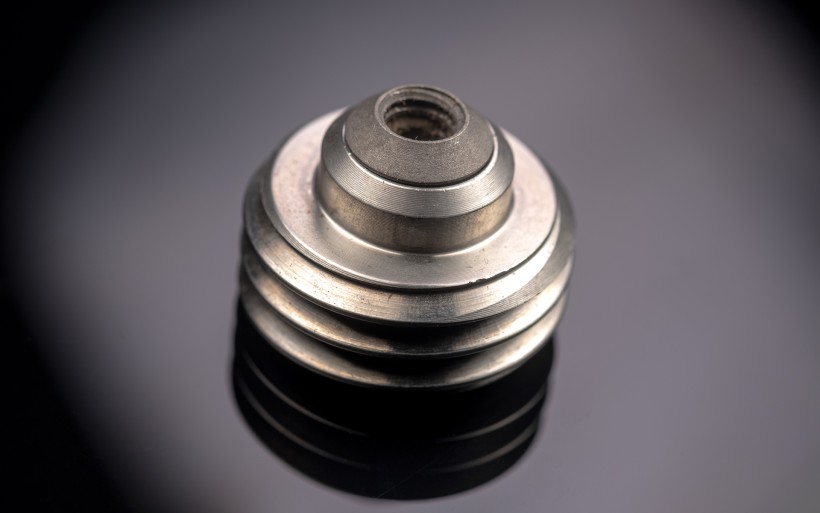 Carbide Base as described was Jeffrey’s first commercially available product that underwent some reworks since its release. This updated version known as Evo remains true to the company’s twin isolation method. It also got 15% shorter due to several adjustments made to its bottom stainless steel section. Zirconia ball bearings used there also grew 50% larger and there’s three of them now, accompanied by twice as many tiny viscoelastic elements to further improve horizontal performance. Machined ridges around top and bottom plates replaced felt pads. Although the original Carbide Base already was executed well, the Evo’s large enclosure feels far nicer and more mature. The difference in this regard is very clear upon comparing both versions. If you’d like to know more about them, please go here.
Carbide Base as described was Jeffrey’s first commercially available product that underwent some reworks since its release. This updated version known as Evo remains true to the company’s twin isolation method. It also got 15% shorter due to several adjustments made to its bottom stainless steel section. Zirconia ball bearings used there also grew 50% larger and there’s three of them now, accompanied by twice as many tiny viscoelastic elements to further improve horizontal performance. Machined ridges around top and bottom plates replaced felt pads. Although the original Carbide Base already was executed well, the Evo’s large enclosure feels far nicer and more mature. The difference in this regard is very clear upon comparing both versions. If you’d like to know more about them, please go here.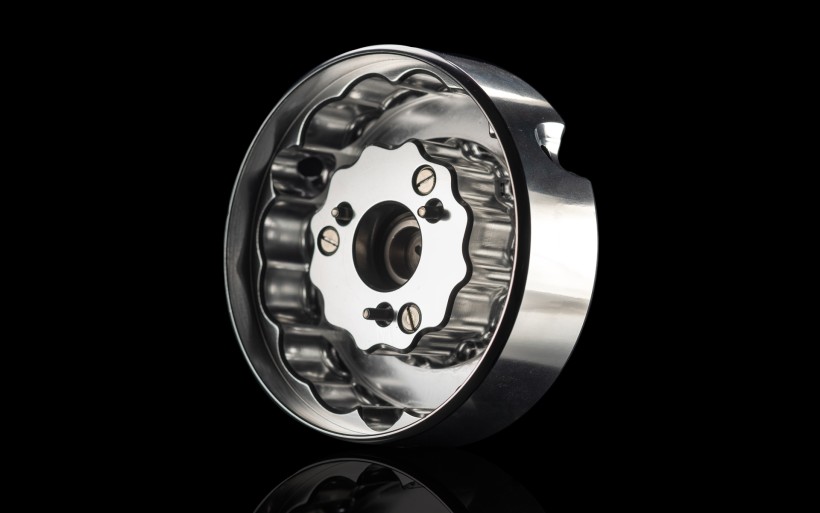 Today’s hero is the company’s latest Diamond take on the Evo footer. The newcomer raises the latter’s complexity further by embedding one extra anti-vibration isolator into its upper section. Jeffrey explained that the work on this additional ball bearing stage started about a year ago. The planned design would leverage the concept of transmission path evasion to improve isolation and damping performance, particularly with minuscule vibrations originating from within electronics. I was told that under the right conditions, a ball bearing continuously rolling within a curved raceway prevents incoming vibrations from exiting back up, which essentially means that these resonances quickly move only from top to bottom. A raceway as smooth as possible is the critical factor for achieving this goal. Since hard zirconia ball bearings focus pressure into an infinitely small point, they can cause an indentation in the raceways upon applying modest weight. This problem called for a fitting solution.
Today’s hero is the company’s latest Diamond take on the Evo footer. The newcomer raises the latter’s complexity further by embedding one extra anti-vibration isolator into its upper section. Jeffrey explained that the work on this additional ball bearing stage started about a year ago. The planned design would leverage the concept of transmission path evasion to improve isolation and damping performance, particularly with minuscule vibrations originating from within electronics. I was told that under the right conditions, a ball bearing continuously rolling within a curved raceway prevents incoming vibrations from exiting back up, which essentially means that these resonances quickly move only from top to bottom. A raceway as smooth as possible is the critical factor for achieving this goal. Since hard zirconia ball bearings focus pressure into an infinitely small point, they can cause an indentation in the raceways upon applying modest weight. This problem called for a fitting solution.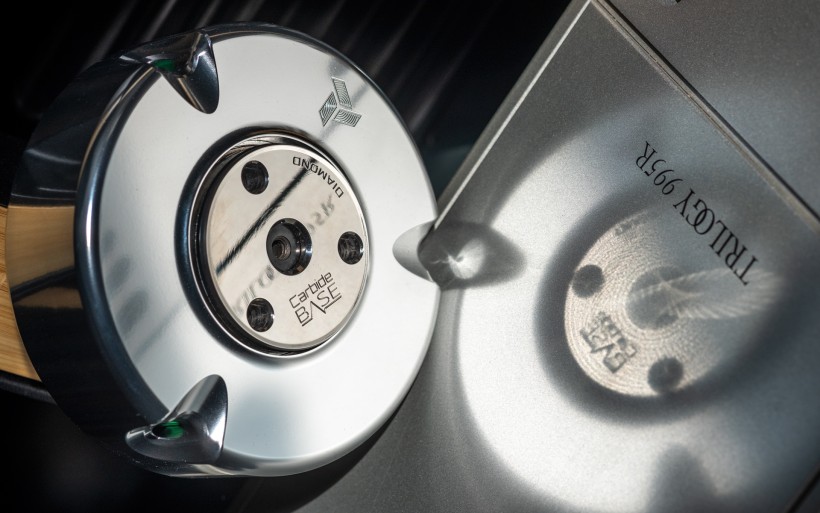 To make raceways in his latest product impervious to indentations, Jeffrey machines them out of solid ceramic via diamond tools. Then these parts undergo thorough polishing to minimize imperfections which can obstruct the bearing’s ability to roll freely there. Then their surfaces are coated with amorphous diamond during a PVD (Physical Vapor Deposition) process. Finished ceramic bits then land inside the new isolator component compatible with standard Carbide Bases. That’s good news for non-Diamond Evo owners who now can order an upgrade kit (€329/ea.) instead of spending coin on new footers. I’ve found this marketing strategy thoughtful and bravo to Jeffrey for going this route. It’s also worth knowing that his ceramic races’ geometry is unusually shallow and wide to prolong a ball bearing’s movement between these parts, which effectively lowers the resonance frequency of the newly developed insert thus the entire product. Although the difference between the Diamond and stock Evo version narrows down to just the 3rd isolator stage, hardness is the well-known key word as far as efficient resonance suppression goes. This new additional anti-vibration structure clearly is all about that. It also features four internal components based on a manganese/copper twin-crystal alloy baptized TwinDampTM. This material undergoes temperature treatments hot and cold in several stages to further boost its damping capabilities, which as I was told are 10x greater than copper.
To make raceways in his latest product impervious to indentations, Jeffrey machines them out of solid ceramic via diamond tools. Then these parts undergo thorough polishing to minimize imperfections which can obstruct the bearing’s ability to roll freely there. Then their surfaces are coated with amorphous diamond during a PVD (Physical Vapor Deposition) process. Finished ceramic bits then land inside the new isolator component compatible with standard Carbide Bases. That’s good news for non-Diamond Evo owners who now can order an upgrade kit (€329/ea.) instead of spending coin on new footers. I’ve found this marketing strategy thoughtful and bravo to Jeffrey for going this route. It’s also worth knowing that his ceramic races’ geometry is unusually shallow and wide to prolong a ball bearing’s movement between these parts, which effectively lowers the resonance frequency of the newly developed insert thus the entire product. Although the difference between the Diamond and stock Evo version narrows down to just the 3rd isolator stage, hardness is the well-known key word as far as efficient resonance suppression goes. This new additional anti-vibration structure clearly is all about that. It also features four internal components based on a manganese/copper twin-crystal alloy baptized TwinDampTM. This material undergoes temperature treatments hot and cold in several stages to further boost its damping capabilities, which as I was told are 10x greater than copper.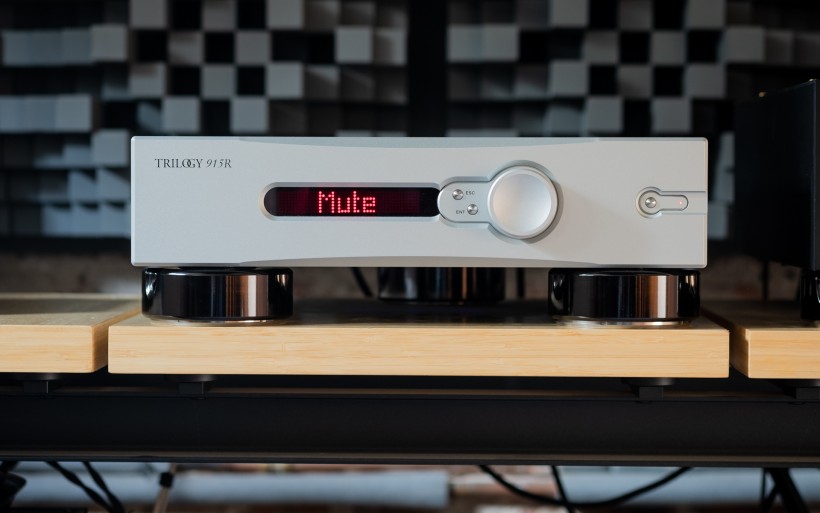 Each Carbide Base Diamond footer sells for €559, which may seem as quite the price hike in comparison to its standard sibling. Turning the already hard materials into their really hard versions is a costly endeavor, however. Danes at Ansuz know a thing or two about that. Their best decoupler puck Z2S priced at €3’500/ea. is prohibitively expensive largely due to the wickedly exotic processing that unlocks its terrific performance. That’s why I wasn’t surprised upon learning that Base Diamond’s raceways alone cost as much as all its other parts combined. Although Jeffrey’s latest footer isn’t the most affordable among its kind by any stretch, it’s nowhere near the financial top either and still promises a lot given how advanced it is. Small hardware atop these massive pucks will look odd to say the least, but that’s just the nature of their hybrid anti-vibration MO and appetite for space to support inner rings. Simply put, Carbide Base Diamond is as compact as it can be to perform the way it does, while the view with three these footers particularly under my DAC floats my subjective boat a lot. Two available finishes – black and silver – are one extra given the accessory type that doesn’t allow for any choices here. The product’s acceptance of bolts and spikes both on top and bottom shows thoughtful engineering and its machining is as good as it gets. Let me stress again that the progress between the original Carbide Base and its latest Diamond version is obvious. Although both are rather industrial lookers, the latter scores extra points on the luxury roster nonetheless. And lastly, Jeffrey is refreshingly open about his work. All the data published at his site builds confidence that he knows what he’s doing.
Each Carbide Base Diamond footer sells for €559, which may seem as quite the price hike in comparison to its standard sibling. Turning the already hard materials into their really hard versions is a costly endeavor, however. Danes at Ansuz know a thing or two about that. Their best decoupler puck Z2S priced at €3’500/ea. is prohibitively expensive largely due to the wickedly exotic processing that unlocks its terrific performance. That’s why I wasn’t surprised upon learning that Base Diamond’s raceways alone cost as much as all its other parts combined. Although Jeffrey’s latest footer isn’t the most affordable among its kind by any stretch, it’s nowhere near the financial top either and still promises a lot given how advanced it is. Small hardware atop these massive pucks will look odd to say the least, but that’s just the nature of their hybrid anti-vibration MO and appetite for space to support inner rings. Simply put, Carbide Base Diamond is as compact as it can be to perform the way it does, while the view with three these footers particularly under my DAC floats my subjective boat a lot. Two available finishes – black and silver – are one extra given the accessory type that doesn’t allow for any choices here. The product’s acceptance of bolts and spikes both on top and bottom shows thoughtful engineering and its machining is as good as it gets. Let me stress again that the progress between the original Carbide Base and its latest Diamond version is obvious. Although both are rather industrial lookers, the latter scores extra points on the luxury roster nonetheless. And lastly, Jeffrey is refreshingly open about his work. All the data published at his site builds confidence that he knows what he’s doing.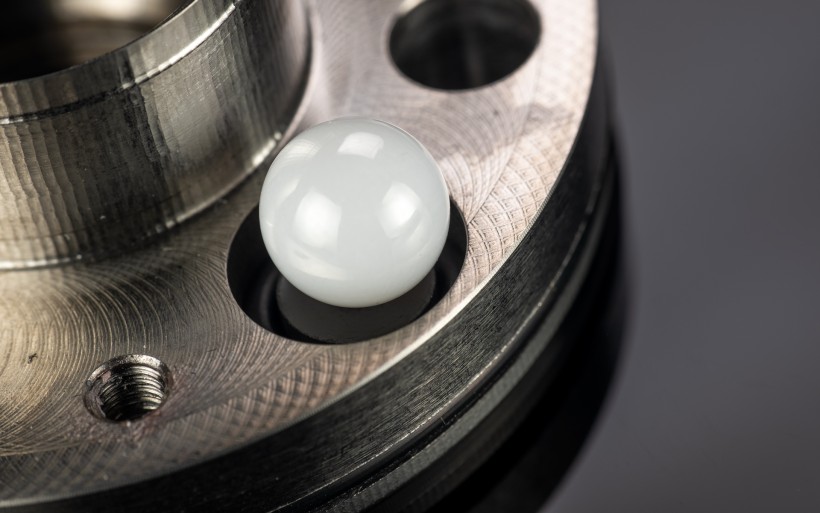 The compact yet unapologetically heavy package from Jeffrey housed a dozen Carbide Base Diamond footers in black, one silver unit for the purpose of photos, a set of four spikes (sold separately for $29) and also the Evo version’s four top sections alone, just in case I felt like comparing them to their older counterparts with felt pads. To be fair, all this lot was more than I needed. Four pucks would’ve sufficed to largely do my part. Still, thrice as many allowed me to replace all stock Carbide Bases I’ve been using (under my preamp, DAC and monitors) and get the full dose of the Diamond effect, which seemed like a really cool thing to do at the very end. Speaking of the original Carbide Base version, prior to its arrival my setup was free from any other standalone anti-vibration pucks. As such it was a welcoming environment for Jeff’s first product, which now was used as the proper competitor for the newcomer. This fight was as unavoidable as it was necessary. The way I see it, many customers who own the basic Evo model probably are curious whether moving to its dearer higher-tiered sibling is worth the investment or not. Although this matter demanded addressing pronto, leveling the battlefield was the first order of business.
The compact yet unapologetically heavy package from Jeffrey housed a dozen Carbide Base Diamond footers in black, one silver unit for the purpose of photos, a set of four spikes (sold separately for $29) and also the Evo version’s four top sections alone, just in case I felt like comparing them to their older counterparts with felt pads. To be fair, all this lot was more than I needed. Four pucks would’ve sufficed to largely do my part. Still, thrice as many allowed me to replace all stock Carbide Bases I’ve been using (under my preamp, DAC and monitors) and get the full dose of the Diamond effect, which seemed like a really cool thing to do at the very end. Speaking of the original Carbide Base version, prior to its arrival my setup was free from any other standalone anti-vibration pucks. As such it was a welcoming environment for Jeff’s first product, which now was used as the proper competitor for the newcomer. This fight was as unavoidable as it was necessary. The way I see it, many customers who own the basic Evo model probably are curious whether moving to its dearer higher-tiered sibling is worth the investment or not. Although this matter demanded addressing pronto, leveling the battlefield was the first order of business.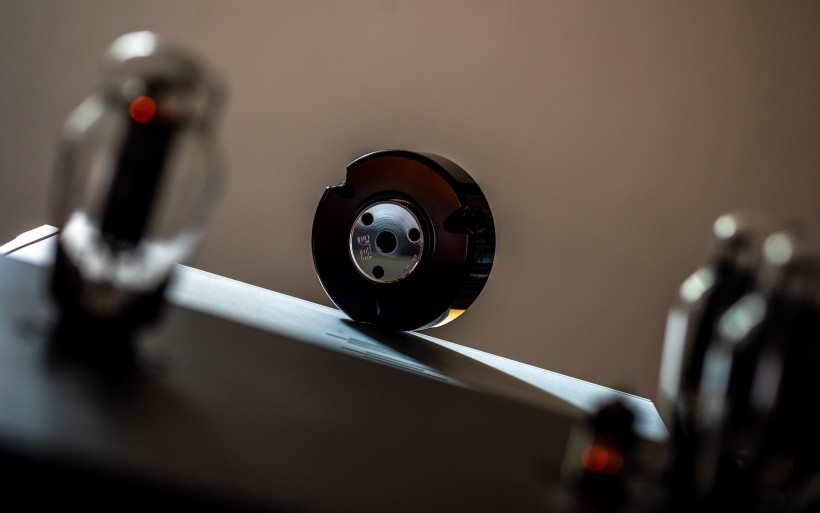 The manufacturer’s suggestion was to use four Diamond footers under each speaker and as many under my DAC. The new super-light green ViscoRing version pre-installed in them was the reason. These inserts boast 20% higher damping capacity versus gray units installed in the original Carbide Bases I’ve been enjoying, at a cost of handling lesser mass. So, three footers per product or four? Green or gray rings? These were the questions to answer prior to moving forward. Good news were that all rubbery bits at my disposal were alike-sized thus swappable. A set of 3/4 green cylinders supports up to 25/35kg components, while their gray counterparts’ respective loading is 50/70kg. My Lampizator Pacific DAC weighs 20kg, Trilogy 915R preamp is 5% lighter and each sound|kaos Vox 3afw monitor fixed to its stand is about 11kg. These numbers suggested using only green ViscoRings considering that being close to their upper support limit was the ticket. In order to compare apples to apples I simply transplanted six inserts from Diamond footers to their older counterparts. With that out of the way I finally could map how much the former pucks’ isolated 3rd anti-vibration stage contributed.
The manufacturer’s suggestion was to use four Diamond footers under each speaker and as many under my DAC. The new super-light green ViscoRing version pre-installed in them was the reason. These inserts boast 20% higher damping capacity versus gray units installed in the original Carbide Bases I’ve been enjoying, at a cost of handling lesser mass. So, three footers per product or four? Green or gray rings? These were the questions to answer prior to moving forward. Good news were that all rubbery bits at my disposal were alike-sized thus swappable. A set of 3/4 green cylinders supports up to 25/35kg components, while their gray counterparts’ respective loading is 50/70kg. My Lampizator Pacific DAC weighs 20kg, Trilogy 915R preamp is 5% lighter and each sound|kaos Vox 3afw monitor fixed to its stand is about 11kg. These numbers suggested using only green ViscoRings considering that being close to their upper support limit was the ticket. In order to compare apples to apples I simply transplanted six inserts from Diamond footers to their older counterparts. With that out of the way I finally could map how much the former pucks’ isolated 3rd anti-vibration stage contributed.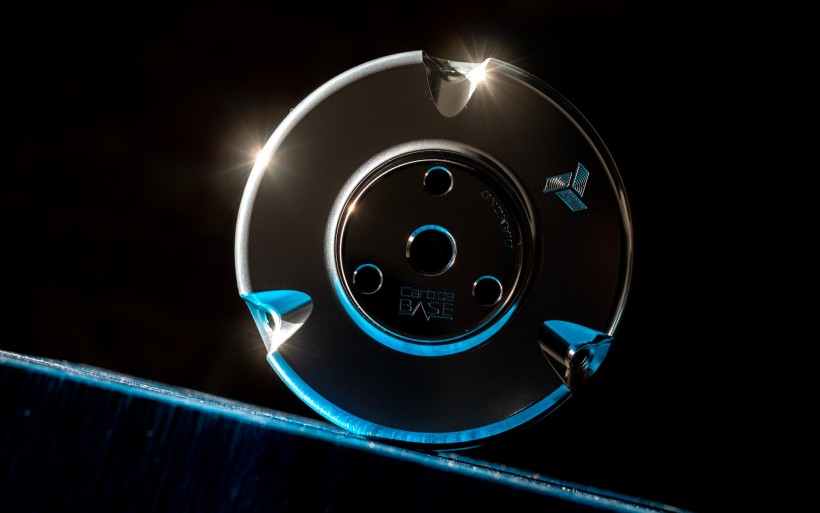 As for the number of Diamond sorters under my hardware, the Lampizator DAC used as the test subject was positioned atop three these accessories. Then one extra was added, I had a listen, then it was removed and so on so forth. Here I should say that stock legs of my reference D/A machine were bypassed, so that its underbelly had direct contact with Jeff’s products. The difference upon going from three to four decouplers was mild to say the least. My ears registered more grounded sound in the former scenario. To clarify, this meant extra mass downstairs and a touch more body above, albeit without crippling the key assets of the Pacific; speed, openness, resolution and its particular spatial emphasis on instrumental and vocal closeness. At this point I knew how many Carbide Bases to apply and with which rings. Both footer versions housed only the green stuff, that was the baseline.
As for the number of Diamond sorters under my hardware, the Lampizator DAC used as the test subject was positioned atop three these accessories. Then one extra was added, I had a listen, then it was removed and so on so forth. Here I should say that stock legs of my reference D/A machine were bypassed, so that its underbelly had direct contact with Jeff’s products. The difference upon going from three to four decouplers was mild to say the least. My ears registered more grounded sound in the former scenario. To clarify, this meant extra mass downstairs and a touch more body above, albeit without crippling the key assets of the Pacific; speed, openness, resolution and its particular spatial emphasis on instrumental and vocal closeness. At this point I knew how many Carbide Bases to apply and with which rings. Both footer versions housed only the green stuff, that was the baseline. Let’s first get back to aural experiments with the original Carbide Bases. Each sound|kaos Vox 3afw’s bottom plate rested on three these pucks and then directly on my listening room’s concrete floor. Back then two swaps sufficed to track impressive sonic shifts. This observation alone was already telling. The sensation with Jeff’s footers was as if SPL in my room got somewhat lower, which wasn’t surprising considering the accessory type. More importantly, vocals with his decouplers on the job were noticeably less coarse and texturally more oil- rather than watercolor-like. These sound sources also were outlined finer and positioned closer to my ears in the process. This action comprised of higher hydration and saturation as much as higher-tiered imaging specificity marked meaningful gains with no strings attached. The greatest upshot was in reduced room wobble. Here I mean upper bass lesser on output, so not as boomy and hollow as before. Lowest octaves of this frequency range however felt more extended, anchored and fuller, as if the Swiss speaker set had developed a way of tapping into the previously unattainable power reserves to consequently produce more visceral, tactile and sensible blows. This noticeably lower bass reach with all its nice benefits and trimmed boominess was a useful reminder. Potent anti-vibration accessories positioned under speakers truly could limit room talk to a meaningful extent. When the associated blur is gone, sound gets clearly better without any downsides. All in all, Carbide bases struck me as brilliant if not unexpected performance boosters/enablers for Martin Gateley’s monitors. These accessories also played their part so well that my take on excessive speaker bloom had altered. If I were a customer, now I’d try anti-vibration means with a troublesome speaker set prior to thinking about letting it go. Maybe it can be rescued.
Let’s first get back to aural experiments with the original Carbide Bases. Each sound|kaos Vox 3afw’s bottom plate rested on three these pucks and then directly on my listening room’s concrete floor. Back then two swaps sufficed to track impressive sonic shifts. This observation alone was already telling. The sensation with Jeff’s footers was as if SPL in my room got somewhat lower, which wasn’t surprising considering the accessory type. More importantly, vocals with his decouplers on the job were noticeably less coarse and texturally more oil- rather than watercolor-like. These sound sources also were outlined finer and positioned closer to my ears in the process. This action comprised of higher hydration and saturation as much as higher-tiered imaging specificity marked meaningful gains with no strings attached. The greatest upshot was in reduced room wobble. Here I mean upper bass lesser on output, so not as boomy and hollow as before. Lowest octaves of this frequency range however felt more extended, anchored and fuller, as if the Swiss speaker set had developed a way of tapping into the previously unattainable power reserves to consequently produce more visceral, tactile and sensible blows. This noticeably lower bass reach with all its nice benefits and trimmed boominess was a useful reminder. Potent anti-vibration accessories positioned under speakers truly could limit room talk to a meaningful extent. When the associated blur is gone, sound gets clearly better without any downsides. All in all, Carbide bases struck me as brilliant if not unexpected performance boosters/enablers for Martin Gateley’s monitors. These accessories also played their part so well that my take on excessive speaker bloom had altered. If I were a customer, now I’d try anti-vibration means with a troublesome speaker set prior to thinking about letting it go. Maybe it can be rescued. When tamed, bloated shaky bass makes room for shorter fiercer more controlled snaps, which we intake as expanded dynamics and higher overall impact. It also turns backdrop for virtual sound sources into even inkier canvas upon which resolution, clarity and oxygenation ramp up. This foundational line of work also makes gentle music genres prettier in a way. With such tasks on the menu Vox speakers atop original Carbide Bases felt more atmospheric, intimate, precise and orderly, just to become far spicier and wilder when zesty heavy tracks were on. That’s exactly how it’s supposed to be. This repertoire demands excitement in form of spatial surprises, finely controlled slams, effortlessness, directness, sensible power, authority and immediacy. Music i.e. by Tool or Queens of the Stone Age makes these traits essentials pretty much. Although steering towards claptrap and shout is very easy with such music served at party-level SPL, the Swiss supported by Carbide pucks was nowhere near crossing that line. Along with cranking up the volume it just gracefully went louder and louder. Upon removing these footers its bass instantly had become lazier, woolier and nowhere near as vital, while vocals morphed into coarser, drier and less sensual versions of themselves. This outcome provided enough data to know that Jeff’s pucks had to stay under the Vox and they did.
When tamed, bloated shaky bass makes room for shorter fiercer more controlled snaps, which we intake as expanded dynamics and higher overall impact. It also turns backdrop for virtual sound sources into even inkier canvas upon which resolution, clarity and oxygenation ramp up. This foundational line of work also makes gentle music genres prettier in a way. With such tasks on the menu Vox speakers atop original Carbide Bases felt more atmospheric, intimate, precise and orderly, just to become far spicier and wilder when zesty heavy tracks were on. That’s exactly how it’s supposed to be. This repertoire demands excitement in form of spatial surprises, finely controlled slams, effortlessness, directness, sensible power, authority and immediacy. Music i.e. by Tool or Queens of the Stone Age makes these traits essentials pretty much. Although steering towards claptrap and shout is very easy with such music served at party-level SPL, the Swiss supported by Carbide pucks was nowhere near crossing that line. Along with cranking up the volume it just gracefully went louder and louder. Upon removing these footers its bass instantly had become lazier, woolier and nowhere near as vital, while vocals morphed into coarser, drier and less sensual versions of themselves. This outcome provided enough data to know that Jeff’s pucks had to stay under the Vox and they did.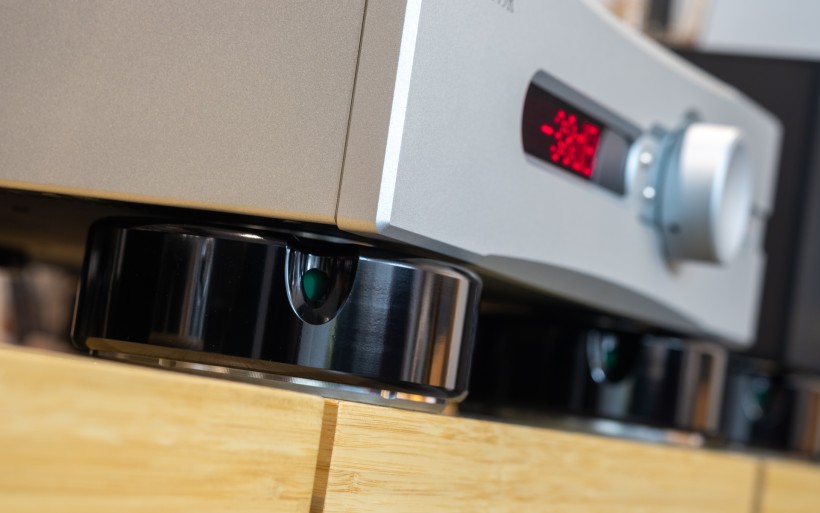 Carbide Bases on duty with the Vox ticked all the right checkboxes at a cost of slightly softer outlines and lower midbass presence, which was a fair price to pay all things considered. Although less pronounced, the Carbide effect was also replicated under Trilogy 915R preamp. Elevated O2 content, increased imaging size, wider dynamic range and sensible instrumental/vocal closeness were uniformly positive changes rather than shifts to the side. Long story short, I saw no reason why this pre shouldn’t sit on Jeff’s footers and the same observation I had after trying them out with my DAC. It sounded gutsier, rounder, faster, more elastic, spatially grander, snappier and dynamically more gifted. These audible upshots were stretched all across the gamut and marked the Lampizator as more susceptible to anti-vibration means than my pre. Upon removing Carbide footers its sound had become more one-sided; lighter, edgier, drier and structurally a touch hollow. The clear takeaway was that this DAC really mustn’t be turned on without these pucks underneath.
Carbide Bases on duty with the Vox ticked all the right checkboxes at a cost of slightly softer outlines and lower midbass presence, which was a fair price to pay all things considered. Although less pronounced, the Carbide effect was also replicated under Trilogy 915R preamp. Elevated O2 content, increased imaging size, wider dynamic range and sensible instrumental/vocal closeness were uniformly positive changes rather than shifts to the side. Long story short, I saw no reason why this pre shouldn’t sit on Jeff’s footers and the same observation I had after trying them out with my DAC. It sounded gutsier, rounder, faster, more elastic, spatially grander, snappier and dynamically more gifted. These audible upshots were stretched all across the gamut and marked the Lampizator as more susceptible to anti-vibration means than my pre. Upon removing Carbide footers its sound had become more one-sided; lighter, edgier, drier and structurally a touch hollow. The clear takeaway was that this DAC really mustn’t be turned on without these pucks underneath.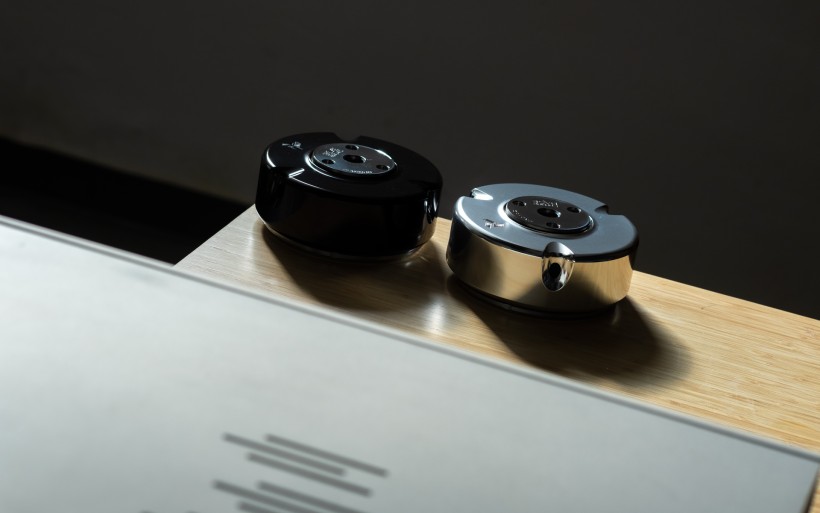 There’s a reason why the above paragraphs describe original Carbide Bases rather than their Diamond incarnation. The input of both these models is exactly the same, so there was no need to reinvent this wheel. Simply put, Diamond footers mimic the original’s behavior, which was expected. The main difference between them is huge, however. Efficacy is the big word here. The newcomer scores far higher on this specific front, which essentially means that a set of these new footers under a component will introduce all the performance gains as explained above, yet substantially more intense thus way easier to hear and appreciate. Let me stress that the difference between the first and latest Carbide Base wasn’t subtle at all, quite the contrary. They’re really far apart on the performance chart, which is rather unusual given their supportive kind. Usually upon moving from such a product to its higher-tiered type we get small quality bumps at a noticeable expense. Not today. Carbide Base Diamond proved a superior next-gen specimen all across the board in comparison to the original, which is enough to justify its existence and see the logic in the price tag listed below. It also had one major ace up its sleeve that I hadn’t seen coming.
There’s a reason why the above paragraphs describe original Carbide Bases rather than their Diamond incarnation. The input of both these models is exactly the same, so there was no need to reinvent this wheel. Simply put, Diamond footers mimic the original’s behavior, which was expected. The main difference between them is huge, however. Efficacy is the big word here. The newcomer scores far higher on this specific front, which essentially means that a set of these new footers under a component will introduce all the performance gains as explained above, yet substantially more intense thus way easier to hear and appreciate. Let me stress that the difference between the first and latest Carbide Base wasn’t subtle at all, quite the contrary. They’re really far apart on the performance chart, which is rather unusual given their supportive kind. Usually upon moving from such a product to its higher-tiered type we get small quality bumps at a noticeable expense. Not today. Carbide Base Diamond proved a superior next-gen specimen all across the board in comparison to the original, which is enough to justify its existence and see the logic in the price tag listed below. It also had one major ace up its sleeve that I hadn’t seen coming.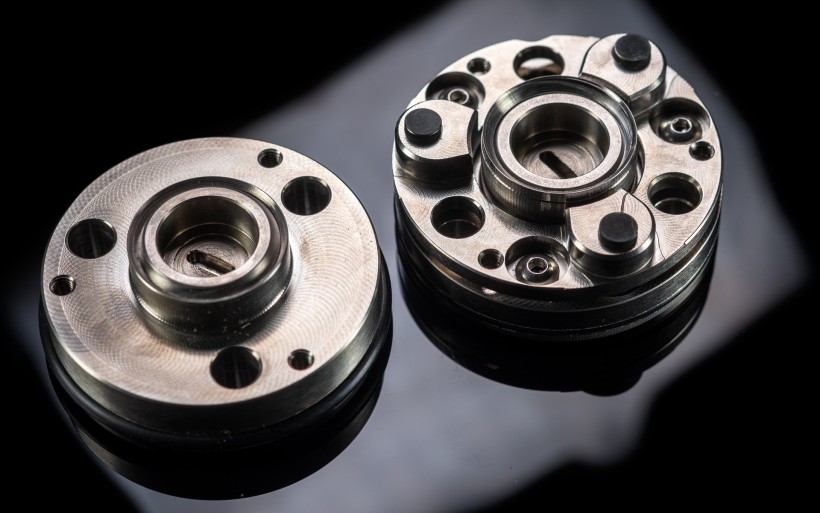 Although Carbide pucks sent my way two springs ago proved beneficial regardless of their application, sound|kaos monitors benefited from their supportive action the most and by far, then my DAC and then the 915R pre. Fast forward to present times and this order is no more. Base Diamond troopers had the most noticeable impact on my DAC. This wasn’t even a contest. The last time I’d heard the Pacific this muscular, raw, fierce and direct was when it sat atop Ansuz Z2S footers. Of course without these zirconium marvels at my disposal I can’t know for sure. Still, the sensation upon using Jeff’s latest product was somewhere in that ballpark and perhaps material hardness as their common denominator has something to do with that. Just so we’re clear, the original Carbide Bases also significantly improved the Pacific’s sound, just not as much as the newcomer did. This exercise led me to believe that Jeff’s extra hard roller-ball stage was just the right fit for digital hardware. In his own review Srajan also had noticed that. He also didn’t spare kind words about Diamond pucks under his subs. Although I don’t own any and my speaker experience was limited to Vox monitors, it was far from disappointing. Diamond decouplers made these boxes spatially bigger and bolder, juicier in the midrange and even more authoritative on bass versus their older counterparts. Base Diamonds also worked wonderfully under the 915R pre, which was hardly any news at this point. And lastly, upon removing all 12 pucks from my system (3 per speaker and as many under my DAC and preamp) it didn’t collapse, but was noticeably shinier, coarser, grittier, more hollow, leaner and nowhere near as spatially sorted, tonally rich and extended on bass. In the context of that platform’s value, the Diamond investment struck me as more than reasonable.
Although Carbide pucks sent my way two springs ago proved beneficial regardless of their application, sound|kaos monitors benefited from their supportive action the most and by far, then my DAC and then the 915R pre. Fast forward to present times and this order is no more. Base Diamond troopers had the most noticeable impact on my DAC. This wasn’t even a contest. The last time I’d heard the Pacific this muscular, raw, fierce and direct was when it sat atop Ansuz Z2S footers. Of course without these zirconium marvels at my disposal I can’t know for sure. Still, the sensation upon using Jeff’s latest product was somewhere in that ballpark and perhaps material hardness as their common denominator has something to do with that. Just so we’re clear, the original Carbide Bases also significantly improved the Pacific’s sound, just not as much as the newcomer did. This exercise led me to believe that Jeff’s extra hard roller-ball stage was just the right fit for digital hardware. In his own review Srajan also had noticed that. He also didn’t spare kind words about Diamond pucks under his subs. Although I don’t own any and my speaker experience was limited to Vox monitors, it was far from disappointing. Diamond decouplers made these boxes spatially bigger and bolder, juicier in the midrange and even more authoritative on bass versus their older counterparts. Base Diamonds also worked wonderfully under the 915R pre, which was hardly any news at this point. And lastly, upon removing all 12 pucks from my system (3 per speaker and as many under my DAC and preamp) it didn’t collapse, but was noticeably shinier, coarser, grittier, more hollow, leaner and nowhere near as spatially sorted, tonally rich and extended on bass. In the context of that platform’s value, the Diamond investment struck me as more than reasonable.
It seems that tubed products meant for low-level signal tasks are the ideal candidates for Carbide Base Diamond. That’s why starting there is my advice if you’re keen to investigate these footers on your own. Then again, considering their profound action also under my speakers and Srajan’s hardware including his subs, you may as well start wherever you please. If you do, brace yourself for quite the ride. This expertly machined competitively priced mechanically adaptive anti-vibration sorter goes way beyond subtle sonic touchups here and there. It changes things a lot, while its superiority over the already accomplished predecessor is a nice cherry on top. Kudos to Jeffrey Jenkins for making that leap!
Associated Equipment:
- Amplifier: Trilogy 995R, FirstWatt F7, Enleum AMP-23R
- DAC: LampizatOr Pacific (KR Audio T-100 / Living Voice 300B + KR Audio 5U4G Ltd. Ed.)
- Speakers: Boenicke Audio W11 SE+, sound|kaos Vox 3afw
- Transport: Innuos Statement, fidata HFAS1-S10U
- Preamplifier: Trilogy 915R, Thöress DFP
- Speaker cables: Boenicke Audio S3, LessLoss C-MARC
- Headphones: HifiMan Susvara
- Speaker signal conditioning: LessLoss Firewall for Loudspeakers, Boenicke ComDev
- Anti-vibration conditioning: 12x Carbide Audio Carbide Bases (under DAC, preamp and speakers)
- Interconnects: LessLoss Entropic Process C-MARC, Boenicke Audio IC3 CG
- Power components: Gigawatt PC-3 SE EVO+/LC-3 EVO, LessLoss C-MARC, LessLoss Entropic Process C-MARC, Boenicke Audio Power Gate, ISOL-8 Prometheus
- USB components: iFi audio Mercury3.0
- Rack: Franc Audio Accesories Wood Block Rack 1+3
- Network: Fidelizer EtherStream, Linksys WRT160N
- Music: NativeDSD
Retail prices of reviewed components in EU (incl. VAT):
- Carbide Base Diamond: €559/ea.
- Base Diamond isolator upgrade: €329/ea.
- A set of four matched spikes: €27
Manufacturer: Carbide Audio








































